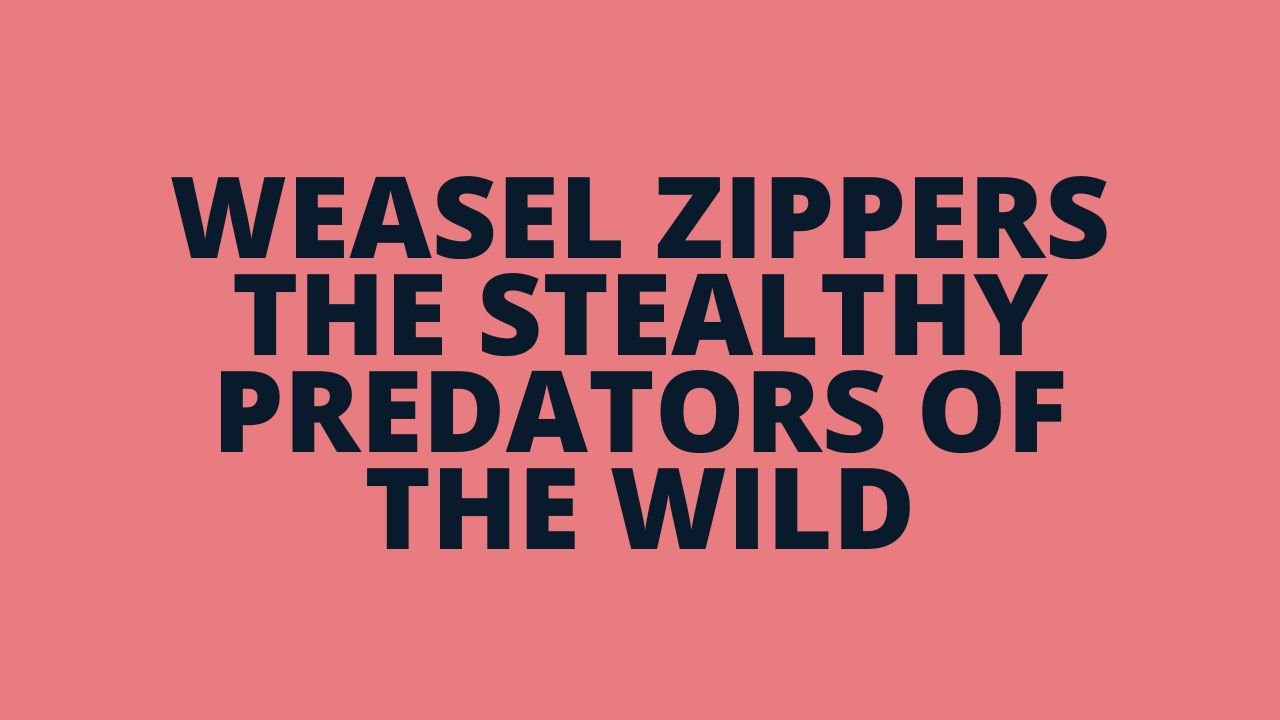Welcome to the untamed realm of Weasel Zippers The Stealthy Predators of the Wild, the stealthy predators that navigate the wild with unparalleled grace. In this comprehensive article, we delve into every aspect of their existence, shedding light on their life, habitat, feeding habits, and crucial role in maintaining ecological balance.
What are Weasel Zippers?
Weasel Zippers are agile predators belonging to the mustelid family. Known for their sleek bodies and sharp instincts, they navigate the wild with exceptional grace. These creatures are not zippers but carnivorous mammals, adept at hunting. Weasel Zippers play a crucial role in ecosystems, contributing to biodiversity and maintaining ecological balance. Their name may be misleading, but these predators are fascinating and essential components of the natural world.
The Life of Weasel Zippers
The life of Weasel Zippers is a testament to the intricacies of the animal kingdom. These agile predators lead dynamic lives, adapting to the challenges of the wild. Solo by nature, Weasel Zippers exhibit fascinating social dynamics, blending independence with occasional interactions. Their existence involves navigating diverse habitats, showcasing adaptability and resilience. Observing the life of Weasel Zippers unveils a captivating story of survival and contribution to the delicate balance of nature.
Habitat and Distribution
Weasel Zippers showcase remarkable adaptability in terms of habitat and distribution. These predators can thrive in various environments, from dense forests to open grasslands. Understanding their preferred habitats provides insights into their distribution patterns across the wild. Their versatility allows them to navigate diverse ecosystems, contributing to their widespread presence. The intricate relationship between Weasel Zippers and their surroundings highlights their role in maintaining ecological balance.
Diet and Feeding Habits
Weasel Zippers are carnivores with a diverse diet, comprising small mammals, birds, and more. Their feeding habits play a crucial role in shaping the delicate balance of the ecosystem’s food chain. Known for their predatory instincts, Weasel Zippers exhibit precision and agility in securing their meals. Understanding their carnivorous palette provides insights into their significant ecological impact. By contributing to the regulation of prey populations, Weasel Zippers play a vital role in maintaining the overall health of their habitats.
Reproduction and Offspring
The reproductive cycle of Weasel Zippers involves fascinating intricacies in ensuring the survival of their species. These agile predators employ strategic reproductive strategies and parental care. Weasel Zippers typically have litters of 3 to 6 offspring, known as kits. The challenges of raising these young ones contribute to the dynamics of their existence in the wild. Exploring the reproduction and offspring aspects unveils the resilience and adaptability crucial for the continuation of the Weasel Zippers’ lineage.
The Role of Weasel Zippers in Ecosystems
Weasel Zippers play a pivotal role in ecosystems, serving as vital contributors to biodiversity and ecological balance. As ecosystem engineers, their presence influences the populations of various species, creating a ripple effect in the intricate web of nature. By participating in predator-prey relationships, Weasel Zippers contribute to the checks and balances necessary for a harmonious environment. Their impact extends beyond direct interactions, showcasing their indirect yet essential role in maintaining the health and stability of diverse ecosystems. Understanding the multifaceted role of Weasel Zippers provides valuable insights into the interconnectedness of the natural world.
Predator-Prey Relationships
In the wild, Weasel Zippers engage in a delicate dance of predator and prey, interacting with various species. These agile predators contribute significantly to the complex web of predator-prey relationships. Their role as both predators and potential prey highlights the intricacies of the natural order. Observing these relationships provides valuable insights into the checks and balances essential for a thriving ecosystem. Weasel Zippers, through their interactions, contribute to the ecological dynamics that shape the wild environment.
Impact on Rodent Populations
Weasel Zippers exert a crucial impact on rodent populations, acting as nature’s pest control. Their carnivorous nature and efficient hunting techniques help regulate rodent numbers. By preying on rodents, Weasel Zippers contribute to preventing unchecked population growth, safeguarding crops and habitats. This natural control mechanism is essential for maintaining ecological balance in various ecosystems. Understanding their role in impacting rodent populations reveals the intricate connections between Weasel Zippers and the overall health of the wild.
Ecological Importance
The ecological importance of Weasel Zippers extends beyond their predatory nature, influencing biodiversity and environmental harmony. These agile predators contribute to the delicate balance of ecosystems by regulating prey populations. By preventing overpopulation, Weasel Zippers indirectly support the diversity of species in their habitats. Their role as ecosystem engineers showcases their impact on maintaining the overall health and stability of diverse environments. Understanding the ecological importance of Weasel Zippers sheds light on their integral role in the intricate tapestry of the natural world.
The Weasel Zipper’s Hunting Techniques
The Weasel Zipper’s hunting techniques are a symphony of stealth and speed, defining their prowess in the wild. Characterized by silent movements and lightning-fast strikes, these techniques make them formidable predators. Weasel Zippers employ strategic approaches, utilizing their agility to surprise and capture prey efficiently. Their hunting style is a testament to their adaptation and survival skills, finely tuned for the wild environment. Observing the nuances of the Weasel Zipper’s hunting techniques unveils the artistry behind their efficient and successful predatory endeavors.
Stealth and Speed
Stealth and speed are the hallmark attributes of Weasel Zippers, setting them apart as agile predators. These creatures move silently, utilizing their keen senses to navigate their surroundings undetected. The combination of stealth and lightning-fast speed makes them effective hunters in the wild. Weasel Zippers employ these traits to surprise and capture prey with remarkable precision. Understanding the interplay between their stealth and speed provides insights into the strategies that make them formidable in their natural habitat.
FAQ
How fast can Weasel Zippers run?
Weasel Zippers are incredibly fast, capable of reaching speeds up to 15 miles per hour.
Do Weasel Zippers live in groups?
While generally solitary, Weasel Zippers may exhibit social behaviors and occasional interactions, but they do not form large groups.
What is the lifespan of a weasel Zipper?
In the wild, Weasel Zippers typically live for about 3 to 4 years.
How many offspring do Weasel Zippers usually have?
Weasel Zippers usually have litters of 3 to 6 offspring, known as kits.
Read More:




Leave a Reply